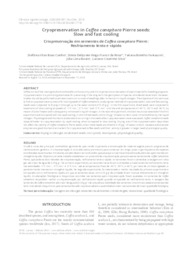Cryopreservation in Coffea canephora Pierre seeds: slow and fast cooling.
Cryopreservation in Coffea canephora Pierre seeds: slow and fast cooling.
Autoria: COELHO, S. V. B.; ROSA, S. D. V. F. da; FANTAZZINI, T. B.; BAUTE, J. L.; SILVA, L. C.
Resumo: Coffee is one of the main agricultural commodities in the country, and it is important to conservation of plant material for breeding programs. Cryopreservation is a promising alternative for preserving in the long-term the germplasm of species considered recalcitrant. However, studies should be performed to achieve maximum survival of seedlings after immersion in liquid nitrogen. The objective of this work was to find a cryopreservation protocol for storing seeds of Coffea canephora, studying two methods of cryopreservation, slow and fast cooling. Seeds were subjected to drying in silica gel up to the water content of 0.25 g g-1. In the first experiment, dried seeds were subjected to treatments of slow cooling at speeds of -1 ºC min-1,-3 ºC min-1 and -5 ºC min-1 until the end temperatures of -40 ºC, -50 ºC and -60 ºC, by means of a bio freezer and subsequently immersed in liquid nitrogen. In the second experiment, the best result was selected of the first experiment and compared with the rapid cooling, in which dried seeds, with 0.25 g g-1 of water content, were immersed directly into liquid nitrogen. Physiological and biochemical alterations occurring in the seeds after cryopreservation were evaluated. Coffea canephora seeds respond better to cryopreservation by rapid cooling, when compared to slow cooling. Drying, one of the cryopreservation steps does not affect the viability of Coffea canephora Pierre seeds, when these seeds are dried to 0.25 g g-1 of water content. Catalase and esterase enzymes are good biochemical markers for cryopreserved coffee seeds and their activity is greater in larger seed physiological quality.
Ano de publicação: 2018
Tipo de publicação: Artigo de periódico
Unidade: Embrapa Café
Observações
1 - Por padrão são exibidas publicações dos últimos 20 anos. Para encontrar publicações mais antigas, configure o filtro ano de publicação, colocando o ano a partir do qual você deseja encontrar publicações. O filtro está na coluna da esquerda na busca acima.
2 - Para ler algumas publicações da Embrapa (apenas as que estão em formato ePub), é necessário ter, no celular ou computador, um desses softwares gratuitos. Sistemas Android: Google Play Livros; IOS: iBooks; Windows e Linux: software Calibre.
Acesse outras publicações
Acesse a Base de Dados da Pesquisa Agropecuária (BDPA) para consultar o acervo completo das bibliotecas da Embrapa.

